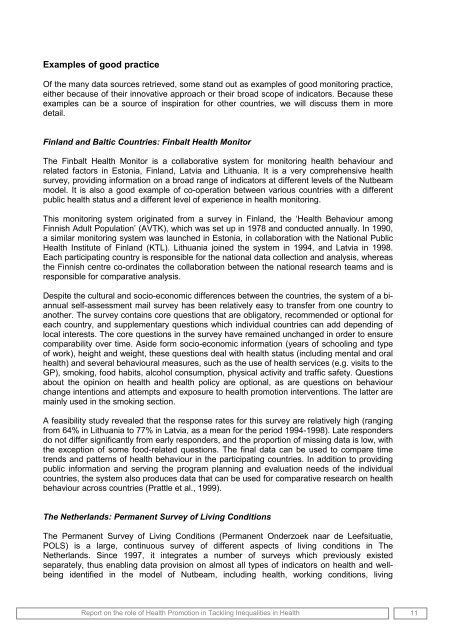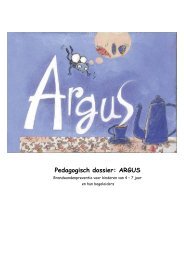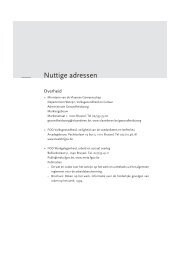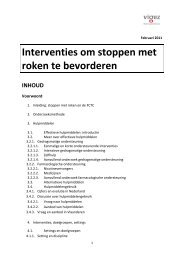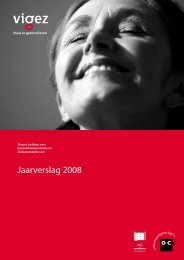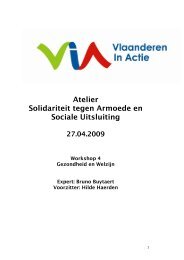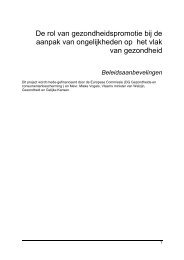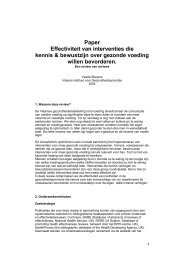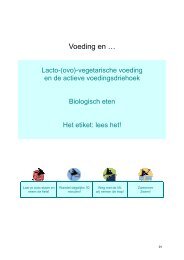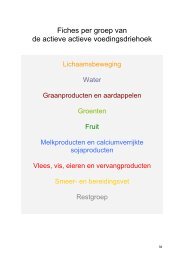Annex 1: Inventory of indicators from surveys and registries
Annex 1: Inventory of indicators from surveys and registries
Annex 1: Inventory of indicators from surveys and registries
Create successful ePaper yourself
Turn your PDF publications into a flip-book with our unique Google optimized e-Paper software.
Examples <strong>of</strong> good practice<br />
Of the many data sources retrieved, some st<strong>and</strong> out as examples <strong>of</strong> good monitoring practice,<br />
either because <strong>of</strong> their innovative approach or their broad scope <strong>of</strong> <strong>indicators</strong>. Because these<br />
examples can be a source <strong>of</strong> inspiration for other countries, we will discuss them in more<br />
detail.<br />
Finl<strong>and</strong> <strong>and</strong> Baltic Countries: Finbalt Health Monitor<br />
The Finbalt Health Monitor is a collaborative system for monitoring health behaviour <strong>and</strong><br />
related factors in Estonia, Finl<strong>and</strong>, Latvia <strong>and</strong> Lithuania. It is a very comprehensive health<br />
survey, providing information on a broad range <strong>of</strong> <strong>indicators</strong> at different levels <strong>of</strong> the Nutbeam<br />
model. It is also a good example <strong>of</strong> co-operation between various countries with a different<br />
public health status <strong>and</strong> a different level <strong>of</strong> experience in health monitoring.<br />
This monitoring system originated <strong>from</strong> a survey in Finl<strong>and</strong>, the ‘Health Behaviour among<br />
Finnish Adult Population’ (AVTK), which was set up in 1978 <strong>and</strong> conducted annually. In 1990,<br />
a similar monitoring system was launched in Estonia, in collaboration with the National Public<br />
Health Institute <strong>of</strong> Finl<strong>and</strong> (KTL). Lithuania joined the system in 1994, <strong>and</strong> Latvia in 1998.<br />
Each participating country is responsible for the national data collection <strong>and</strong> analysis, whereas<br />
the Finnish centre co-ordinates the collaboration between the national research teams <strong>and</strong> is<br />
responsible for comparative analysis.<br />
Despite the cultural <strong>and</strong> socio-economic differences between the countries, the system <strong>of</strong> a biannual<br />
self-assessment mail survey has been relatively easy to transfer <strong>from</strong> one country to<br />
another. The survey contains core questions that are obligatory, recommended or optional for<br />
each country, <strong>and</strong> supplementary questions which individual countries can add depending <strong>of</strong><br />
local interests. The core questions in the survey have remained unchanged in order to ensure<br />
comparability over time. Aside form socio-economic information (years <strong>of</strong> schooling <strong>and</strong> type<br />
<strong>of</strong> work), height <strong>and</strong> weight, these questions deal with health status (including mental <strong>and</strong> oral<br />
health) <strong>and</strong> several behavioural measures, such as the use <strong>of</strong> health services (e.g. visits to the<br />
GP), smoking, food habits, alcohol consumption, physical activity <strong>and</strong> traffic safety. Questions<br />
about the opinion on health <strong>and</strong> health policy are optional, as are questions on behaviour<br />
change intentions <strong>and</strong> attempts <strong>and</strong> exposure to health promotion interventions. The latter are<br />
mainly used in the smoking section.<br />
A feasibility study revealed that the response rates for this survey are relatively high (ranging<br />
<strong>from</strong> 64% in Lithuania to 77% in Latvia, as a mean for the period 1994-1998). Late responders<br />
do not differ significantly <strong>from</strong> early responders, <strong>and</strong> the proportion <strong>of</strong> missing data is low, with<br />
the exception <strong>of</strong> some food-related questions. The final data can be used to compare time<br />
trends <strong>and</strong> patterns <strong>of</strong> health behaviour in the participating countries. In addition to providing<br />
public information <strong>and</strong> serving the program planning <strong>and</strong> evaluation needs <strong>of</strong> the individual<br />
countries, the system also produces data that can be used for comparative research on health<br />
behaviour across countries (Prattle et al., 1999).<br />
The Netherl<strong>and</strong>s: Permanent Survey <strong>of</strong> Living Conditions<br />
The Permanent Survey <strong>of</strong> Living Conditions (Permanent Onderzoek naar de Leefsituatie,<br />
POLS) is a large, continuous survey <strong>of</strong> different aspects <strong>of</strong> living conditions in The<br />
Netherl<strong>and</strong>s. Since 1997, it integrates a number <strong>of</strong> <strong>surveys</strong> which previously existed<br />
separately, thus enabling data provision on almost all types <strong>of</strong> <strong>indicators</strong> on health <strong>and</strong> wellbeing<br />
identified in the model <strong>of</strong> Nutbeam, including health, working conditions, living<br />
Report on the role <strong>of</strong> Health Promotion in Tackling Inequalities in Health<br />
11


